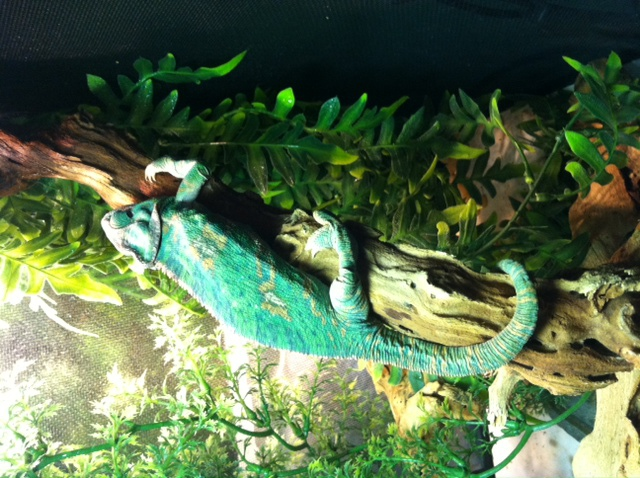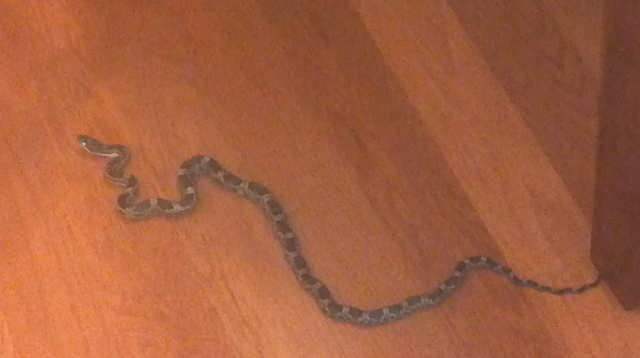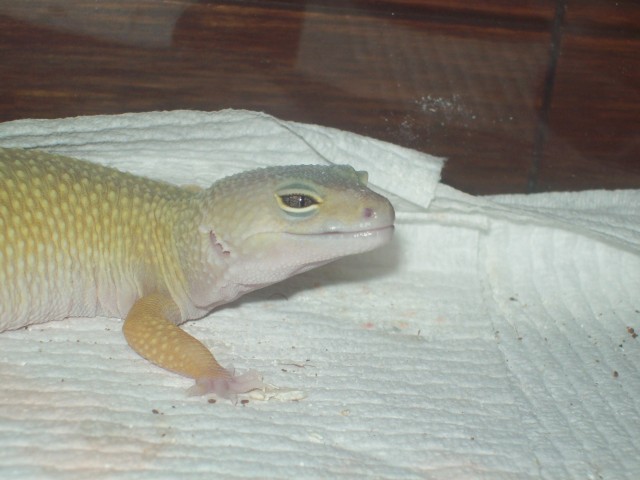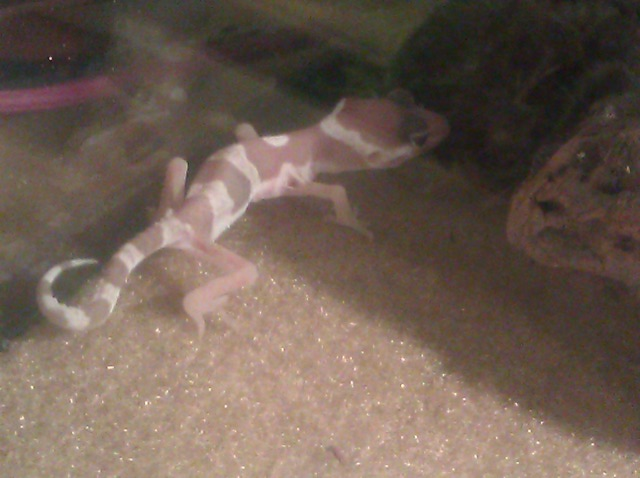QuestionQUESTION: I have a juvenile Leopard Gecko that, for the most part, has done well since I have brought him home. The first few days, he seemed to have no problems adjusting to his new home. He readily ate between 6-9 crickets daily, and was fairly active. In the last 2-3 days, however, he has been much more lethargic, is not as interested in his cricket meals when provided, and has also passed one very runny stool. I have him housed in a 20 gal long glass aquarium with it about 88-91 degrees F on the warm end and 79-81 deg F on the cool end. Fresh water is provided daily, his substrate consists of "reptile carpet" and his crickets are dusted with vitamin/calcium supplement powder, as well as a dish of this supplement available in the tank. Of course, a humid hide is provided on the warm end with humidity levels right outside the hide usually around 25%. The only reason I am concerned is due to the fact he has recently become more lethargic and eats fewer crickets (although he does still eat). Also, I have only observed one runny stool, but it did worry me. Do you think a trip to the herp vet is in order? Thanks for your help!
ANSWER: Hi Bryant,
I would make that vet appointment. Is he going to the bathroom on a regular basis? If yes, then my following comment about blockage can be ignored. I'm guessing you have only had him a few days and what concerns me is he may have a blockage of some sort. (if not going to the bathroom regular) Do you know what the store was keeping him on as to substrate? If it was sand or other loose substrate, then it very well could be a blockage.
I would also have a fecal done for internal parasites, which can cause the loose stool. Stress can cause their normal parasite load (yep, they need to have some internal parasites) to increase. Stress comes from just moving to a new home. Its great that he is eating...so most likely its not a blockage problem..but just something I wanted to alert you on. Blockages can also be caused by internal parasites...
It sounds like you are doing everything right....I've included a basic care sheet that I wrote to help people out. It also includes links to finding a vet that is able to treat reptiles.
You may want to get your cool area a few degrees cooler...they do need those lower temperatures to basically reset their systems daily.
Also, only use a plain calcium for daily dusting the insects...and the vitamin powder, once, at the most twice a week.
BASIC CARE FOR A LEOPARD GECKO
Leopards are pretty easy to care for but they do need
special care. Here are some of the basic needs of your gecko.
HOUSING: The need to have at least a 20 gallon long tank for one Leo. This needs to have a secure fitting screen top...they can be quite the escape artists!!! They need to have a humid hide box.You can make this with something as simple as a small plastic dish with a hole cut in one side and a small mesh bag filled with some Sphagnum moss coconut bark or Peat moss that you mist.
I made mine out of the small plastic folgers coffee containers...I cut an opening in the lid..and put the moss in..they LOVE it. I use the terrarium moss in mine.
I use that on the warm side of the tank. Be sure to provide a cool hidebox on the other end. I also provide a mid temperature hide...which is in the middle of the tank.I use the critter caves which you can purchase. NOT the ones that have heat in them!!!!
Provide secure climbing areas for your gecko. Fake plants, rocks and branches are all fine to use. be sure there are no wires or sharp ends to any fake plants you use.
*****SUBSTRATE:(that's the stuff on the floor of your tank) Newspaper, lizard carpet or paper towels work great and are easy to clean and are much safer than any loose substrate. Sand or other loose substrate is not recommended as that they can be deadly to the leo when it is ingested(eaten, even by accident while eating their insects)...A very graphic site of an impacted leo surg can be seen at http://homepage.mac.com/exoticdvm/reptile/PhotoAlbum181.html it is very graphic!!! ******What I have found that works great for safety and heat distribution is using about 1/4 inch of childrens play sand(since the tiles fit tight together, there is no sand danger) on the bottom of the tank and on top that you place ceramic or slate floor tile. What is nice is that the 12 x 12 squares fit perfect in a 20 gallon tank with no spaces between the tiles. The sand and the tile distribute the heat wonderfully. Using the under tank heater as described is what distributes the heat. Also, overhead heat will help in heating the tiles...I've been using this set up for several years and the leos love it. Using a tile that isn't smooth is recommended. **********
TEMPERATURES: They need a warm area of 88-92 degrees and a
cooler area in the upper 70s, low 80s. At night their temperature can drop to the low to mid 70's.
Never use a hot rock for a leopard gecko...or any reptile.
They can severely burn any reptile. You can use a heating
pad under the tank,under tank heater, or you can use a regular household lightbulb in a dome fixture with a ceramic socket in it to keep the warm area at the 88-90 degree area.At night, no white light. If room temperatures stay above 70 degrees, no extra night heat is needed. The undertank heater or heating pad should cover about 1/3 of the tank....be sure to raise the tank up about 1/4-1/2 inch off the stand when using an undertank heat source to prevent heat build up which can cause the glass to break and hot spots in the glass. Be sure to have a good layer of newspaper, carpeting or, even a thin flat rock(such as tile) on top the area that the undertank heat source is placed...if you use a thin rock or tile, it helps to distribute the heat very well.
You can use the special nighttime lights that are designed for reptiles. I like using a ceramic heat emitter on a thermostat for nighttime heat.
DO NOT use black lights or party lights as they can cause eye damage!!!!
The wattage you use will vary based on room temperature and size of tank.
LIGHTING: Leopard geckos do not need UVB lighting but it does not hurt them to give them uvb. They should have some type of light during the day, be it a uvb tube, regular florescent light, reptile day light or regular household lightbulb. NO white lights at night!!!
FEEDING: Geckos should not be fed crickets or other insects that are bigger than the space between their eyes. Generally, hatchlings can be fed more than once a day,juvys can be fed twice a day, adults are fed once daily or every other day, in the early evening. Crickets and other food items such as silk worms, superworms, and an occasional treat of a wax worm, need to be dusted with a calcium supplement two times a week and also they should have a small dish of calcium in their tank. I use the lid of a milk jug for the little dish of calcium in their tank. For dusting the insects, Use a calcium with no added phosphorus. Insects must be gut loaded(fed) for at least 48 hours prior to feeding your gecko. Remove any uneaten crix or superworms after 15-20 minutes..... Place a piece of cut potato in the tank so that if you have missed any uneaten insects, they will eat the potato instead of nibbling on your gecko!!!
*************You have to be sure to feed your crickets and insects the right foods before feeding them to your gecko. If your crickets/insects are not healthy and well fed, your gecko will not get the nutrition he needs. You can gut load your crickets and insects greens, veggies, cereals or specially designed commercial foods for crickets or the insects you are feeding. ************
Be sure to have a small dish of clean water for your gecko at all times!!
You can offer them some baby food or fruits on occasion ...
Mine will even eat a small piece of watermelon now and then.WATER: always provide a dish of drinking water. If you choose to mist your gecko to drink, its best to not get the tank too wet as that they do not do well with higher humidity. Sometimes its better to take your leo out of their tank to mist them to get them to drink!!!
HANDLING: Some geckos enjoy being held...others prefer not to be handled at all. Be sure to be very gentle when holding your leo and NEVER grab them by the tail! Their tails are extremely fragile and will break.
I do suggest finding a vet that can treat reptiles BEFORE you actually need one!!! To find a vet that is able to care for reptiles:
http://www.anapsid.org/vets
http://www.arav.org/Directory.htm
For more information on leopard geckos:
http://www.thegeckospot.com/leocareindex2.html
http://www.drgecko.com
If you have any questions or don't understand something, please let me know
---------- FOLLOW-UP ----------
QUESTION: Ok, the vet appointment has been made and yes, he has been going to the bathroom regularly, just the one loose stool, the rest have been normal. Do you have any suggestions, other than buying a larger enclosure, on how to get the cool end cooler? Also, would you recommend just calcium supp. or calcium with D3 also? You have been a great help, and so has my vet, thanks!
AnswerHi Bryant,
Good on the vet appointment and good on the going to the bathroom!!!
A 20 gallon is a great size tank for the leo.
I would probably go with an under-tank heater on the warm end...(they are cheap,remember only want one to cover 1/3 of the tank) and then a lower wattage bulb for over head in that area. The overhead will heat the cave under it, and the under-tank heater will warm the floor of the tank on that end. Its one reason why I love using the slate tiles as I describe in the care sheet. With the 20 gal. long tank, there are tiles that fit perfectly in them. Two 12x12 tiles and one 6x12 tile fit like they were custom made. The tiles are really inexpensive. Home Depot or Lowes carries them That way, your humid hide and a warm "cave" will be on that end. The rest of the temperatures should take care of themselves then.
Make sure your tank isn't in an area that gets direct sun as that will add to the temperatures.
Depending on where and with what you are measuring the temperatures, you may find that yours are actually correct. For the cool end, measure them down low..that's where the leo will be... for the warm end, measure where the hide is sitting. It's why the under-tank heaters along with a daytime overhead heat source work well.
For dusting the insects 1-2 times a week I use the Calcium with D3...for in their little "dish" of it in their tanks, I use the plain calcium.

 1 year old female veiled chameleon
QuestionLizzy
Lizzys Setup
QUESTION: I ha
1 year old female veiled chameleon
QuestionLizzy
Lizzys Setup
QUESTION: I ha
 What type of snake did I find in my house?
Question
Snake Mouse
Hello,
I live in Nas
What type of snake did I find in my house?
Question
Snake Mouse
Hello,
I live in Nas
 Whats wrong with me Gecko, not eating, lump?!?! HELP!
QuestionQUESTION: Okay, So I think my leopard gecko may
Whats wrong with me Gecko, not eating, lump?!?! HELP!
QuestionQUESTION: Okay, So I think my leopard gecko may
 Little Leo Gecko SICKKK
Question
Leo Gecko Sick
I just recently bo
Little Leo Gecko SICKKK
Question
Leo Gecko Sick
I just recently bo
 Gravid Leopard Gecko?
QuestionBelly
QUESTION: Hello,
Im pretty new to
Gravid Leopard Gecko?
QuestionBelly
QUESTION: Hello,
Im pretty new to